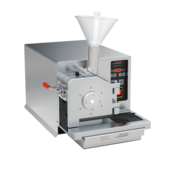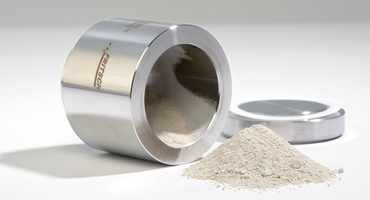Torna alla panoramica
Sample preparation of cannabis plants
Cannabis has been used as a medicine in various cultures for thousands of years

for example as marijuana (dried leaves and flowers) or as hashish (the resin of the female plant). Today Tetrahydrocannabinol (THC) and Cannabidiol (CBD) are particularly isolated and researched from the multitude of active substances contained in the plant (in addition to other cannabinoids and terpenes) as pharmacologically effective components.
Sticky and tricky – the translucent structures that are seen producing from the cannabis flower are trichomes. These structures are resinous & sticky and contain the vast majority of biologically active cannabinoid and terpene compounds. This is a challenging material for milling - see picture on the right.
The cannabis active ingredients are used therapeutically in particular
- as pain reliever
- for appetite stimulation
- anti-inflammatory
- antispasmodic
Supercritical CO2 Extraction

The most common method to extract the active ingredients from the cannabis plant is supercritical CO2 extraction. At above 31°C and with high pressure the CO2 gets into the "supercritical" state. It now acts as a solvent. It is passed through a chamber containing the plant material. The CO2 has still the density of a liquid, but can fill the entire chamber like a gas. This is ideal for extraction as it does not cause denaturation or damage to the product.
The CO2 extracts the cannabinoids and terpenes from the plant. The result is a safe, high-quality, pure oil, which can now be processed for various therapeutic applications. The producers of these cannabis oils naturally want to make the extraction process as efficient as possible. That means: the highest possible yield of the ingredients in the shortest possible time.
Homogeneous grinding of cannabis
The requirement for this is an optimal, homogeneous grinding of the cannabis plant. The ideal instrument for this is the FRITSCH PULVERISETTE 19 – an Universal Cutting Mill for fine grinding and for precise comminution.


Perfect grinding chamber geometry
In cutting mills, the sample is shredded between the knives of the rotor and the counter knives in the grinding chamber using the principle of a pair of scissors to produce the desired final fineness. The unique grinding chamber geometry of the FRITSCH Universal Cutting Mill PULVERISETTE 19 ensures minimal dead space. The progressive cutting geometry between the rotor and stator knives actively transports the sample material. It cannot get stuck anywhere. The special air flow is the basis for quick, clog-free work and quick residue-free cleaning. In addition, the use of the stainless-steel high-performance Cyclone separator ensures high throughput.
With the help of an industrial vacuum cleaner and the high-performance Cyclone separator, a negative pressure is generated in the grinding chamber. The material is fed into the FRITSCH PULVERISETTE 19 via a funnel. Different sieve cassettes define the final fineness of the cannabis sample. Unmilled cannabis plant material has a bulk density of 100-125 g/litre, while ground material has a bulk density of 225-250 g/litre.
The sample is optimally homogenised by the grinding and significantly more material can be filled into the extraction column. Of course, this also significantly increases the yield per extraction.
In cooperation with OutCo, a cannabis producer in California, USA, we examined which degree of grinding means the optimum for the most efficient extraction. The best results are achieved with the 2 mm sieve. Other screens can also be used for different fractions.


More PULVERISETTE 19 facts

The FRITSCH Universal Cutting Mill PULVERISETTE 19 is also used to grind samples for the potency testing or to examine the material for pesticide residues. In order to optimally adapt the cutting performance to the sample, the speed of the rotor can be regulated between 300 rpm to 3000 rpm.
As with all mills used in analytical laboratories, simple cleaning is desirable. The concept of the Clean Design was used for the FRITSCH PULVERISETTE 19: the grinding chamber can be opened completely, all grinding parts can be removed without tools for easy and fast cleaning. Cross contamination can be effectively avoided.
The FRITSCH PULVERISETTE 19 is also available in a 316L stainless steel version for use in the pharmaceutical sector.
-
Download the FRITSCH-report as PDF file
-
Detailed grinding reports
-
Sources and interesting links
Dr. Markus Roggen, CBDV, Complex Biotech Discovery Venture Ltd., Vancouver, Canada
Blake Grauerholz, OutCo, El Cajon, California, USA* Dear visitor, When clicking on this external link you are leaving the website of Fritsch Germany. Fritsch Germany is not responsible for the content of the external website and has no influence on it. Please note that external websites may be outside the scope of protection of the EU-DSGVO. Visit us again soon, Your FRITSCH Team Milling and Sizing
Further information on Cannabis Processing under Extractionsbestbud.com
Brochure Sample Preparation, QC, Formulations - Benchtop solutions for Cannabis & Hemp applications
Brochure Cannabis & Hemp - Processing, Sample Preparation & Automation
Torna alla panoramica





